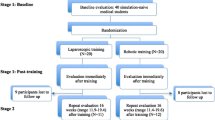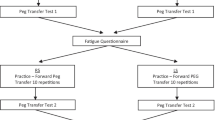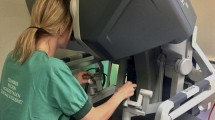Abstract
Background
Although surgical simulation provides an effective supplement to traditional training, it is not known whether skills are transferable between minimally invasive surgical modalities. The purpose of this study was to assess the transferability of skills between minimally invasive surgical simulation platforms among simulation-naïve participants.
Methods
Forty simulation-naïve medical students were enrolled in this randomized single-blinded controlled trial. Participants completed a baseline evaluation on laparoscopic (Fundamentals of Laparoscopic Surgery Program, Los Angeles, CA) and robotic (dV-Trainer, Mimic, Seattle, WA) simulation peg transfer tasks. Participants were then randomized to perform a practice session on either the robotic (N = 20) or laparoscopic (N = 20) simulator. Two blinded, expert minimally invasive surgeons evaluated participants before and after training using a modified previously validated subjective global rating scale. Objective measures including time to task completion and Mimic dV-Trainer motion metrics were also recorded.
Results
At baseline, there were no significant differences between the training groups as measured by objective and subjective measures for either simulation task. After training, participants randomized to the laparoscopic practice group completed the laparoscopic task faster (p < 0.003) and with higher global rating scale scores (p < 0.001) than the robotic group. Robotic-trained participants performed the robotic task faster (p < 0.001), with improved economy of motion (p < 0.001), and with higher global rating scale scores (p = 0.006) than the laparoscopic group. The robotic practice group also demonstrated significantly improved performance on the laparoscopic task (p = 0.02). Laparoscopic-trained participants also improved their robotic performance (p = 0.02), though the robotic group had a higher percent improvement on the robotic task (p = 0.037).
Conclusions
Skills acquired through practice on either laparoscopic or robotic simulation platforms appear to be transferable between modalities. However, participants demonstrate superior skill in the modality in which they specifically train.

Similar content being viewed by others
References
Yu et al (2012) Use, costs and comparative effectiveness of robotic assisted, laparoscopic and open urological surgery. J Urol 187(4):1392–1399
Kenngott HG, Muller-Stich BP, Reiter MA, Rassweiler J, Gutt CN (2008) Robotic suturing: technique and benefit in advanced laparoscopic surgery. Minim Invasive Ther Allied Technol 17:160–167
Lanfranco A, Castellanos A, Desai J, Meyers W (2004) Robotic surgery: a current perspective. Ann Surg 239:14–21
Lenihan JP Jr, Kovanda C, Seshadri-Kreaden U (2008) What is the learning curve for robotic assisted gynecologic surgery? J Minim Invasive Gynecol 15:589–594
Dev HS, Sooriakumaran P, Stolzenburg JU, Anderson CJ (2012) Is robotic technology facilitating the minimally invasive approach to partial nephrectomy? BJU Int 109(5):760–768
Ahlering TE, Skarecky D, Lee D, Clayman RV (2003) Successful transfer of open surgical skills to a laparoscopic environment using a robotic interface: initial experience with laparoscopic radical prostatectomy. J Urol 170:1738–1741
Blavier A, Gaudissart Q, Cadiere GB, Nyssen AS (2007) Comparison of learning curves and skill transfer between classical and robotic laparoscopy according to the viewing conditions: implications for training. Am J Surg 194:115–121
Burkett D, Horwitz J et al (2011) Assessing current trends in resident hysterectomy training. Female Pelvic Med Reconstr Surg 17(5):210–214
Banks EH, Chudnoff S, Karmin I, Wang C, Pardanani S (2007) Does a surgical simulator improve resident operative performance of laparoscopic tubal ligation? Am J Obstet Gynecol 197(541):e1–e5
Larsen CR, Soerensen JL, Grantcharov TP et al (2009) Effect of virtual reality training on laparoscopic surgery: randomised controlled trial. BMJ 338:b1802
Gala R, Orejuela F, Gerten K et al (2013) Effect of validated skills simulation on operating room performance in obstetrics and gynecology residents: a randomized controlled trial. Obstet Gynecol 121:578–584
Seymour NE, Gallagher AG, Roman SA et al (2002) Virtual reality training improves operating room performance: results of a randomized, double-blinded study. Ann Surg. 236:458–463 (Discussion 63–4)
Goh AC, Goldfarb DW, Sander JC, Miles BJ, Dunkin BJ (2012) Global evaluative assessment of robotic skills: validation of a clinical assessment tool to measure robotic surgical skills. J Urol 187(1):247–252. doi:10.1016/j.juro.2011.09.032
Vassiliou MC, Feldman LS, Andrew CG et al (2005) A global assessment tool for evaluation of intraoperative laparoscopic skills. Am J Surg 190(1):107–113. doi:10.1016/j.amjsurg.2005.04.004
Reznick R, Regehr G, MacRae H, Martin J, McCulloch W (1997) Testing technical skill via an innovative “bench station” examination. Am J Surg 173:226–230
Dawe SR, Pena GN, Windsor JA et al (2014) Systematic review of skills transfer after surgical simulation-based training. Br J Surg 101:1063–1076
Panait L, Shetty S, Shewokis PA, Sanchez JA (2014) Do laparoscopic skills transfer to robotic surgery? J Surg Res 187:53–58
Anderberg M, Larsson J, Kockum CC, Arnbjornsson E (2010) Robotics versus laparoscopy—an experimental study of the transfer effect in maiden users. Ann Surg Innov Res 4:3
Hassan SO, Dudhia J, Syed LH et al (2015) Conventional laparoscopic vs robotic training: which is better for naive users? a randomized prospective crossover study. J Surg Educ 72:592–599
Author information
Authors and Affiliations
Corresponding author
Ethics declarations
Disclosures
An educational loan of the Mimic dV-trainer was provided by Mimic Simulation to complete the study. Drs. Thomaier, Orlando, Abernethy, Paka, and Chen have no other financial disclosures or conflicts of interest.
Rights and permissions
About this article
Cite this article
Thomaier, L., Orlando, M., Abernethy, M. et al. Laparoscopic and robotic skills are transferable in a simulation setting: a randomized controlled trial. Surg Endosc 31, 3279–3285 (2017). https://doi.org/10.1007/s00464-016-5359-y
Received:
Accepted:
Published:
Issue Date:
DOI: https://doi.org/10.1007/s00464-016-5359-y




